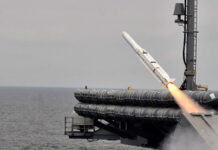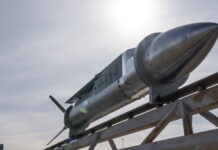Raytheon Technologies has delivered all 23 contracted Joint Precision Approach and Landing System (JPALS) low-rate production units to the US Navy on time or ahead of schedule, the company announced on 23 March 2023.
JPALS is a software-based GPS navigation and precision approach landing system that is deployed on all US Navy aircraft carriers and amphibious assault ships that guides aircraft in to land regardless of sea state or weather conditions, bolstering safety and operational capability. The system is integrated on the F-35 Joint Strike Fighter and is deployed on two international platforms, the UK Royal Navy’s two Queen Elizabeth-class carriers and the Italian aircraft carrier ITS Cavour, to support their F-35 operations.
In February 2023 the US Navy awarded Raytheon a USD 8 M (EUR 7.38 M) Foreign Military Sales contract to integrate JPALS onto Japan’s JS Izumo, which began its service as a helicopter carrier but is being converted into a light aircraft carrier for F-35 operations.

“This is a significant milestone for the JPALS team and highlights the incredible efforts of hundreds of our teammates over the past decade who developed and now have fully delivered these critical systems that our warfighters and international partners need,” Captain Kevin Watkins, programme manager for Naval Air Traffic Management Systems at US Naval Air Systems Command, was quoted as saying in a Raytheon press release. “This team overcame many barriers over the past several years, successfully achieving the required outcome to deliver all of the capabilities needed, on time and affordably.”
“Since contract award in 2019 our team has worked closely with Naval Air Systems Command to outfit the fleet’s carriers and ships with JPALS to ensure pilots can land safely and successfully anywhere in the world,” Mark Maselli, Raytheon Technologies’ JPALS programme manager, was quoted as saying in the same press release.
Raytheon has also developed an expeditionary variant of JPALS called eJPALS, which is a smaller, portable system that could be packaged in ruggedised cases, mounted on small vehicles and deployed in austere, remote locations to facilitate precision landings.
Peter Felstead






![Raytheon UK Leads Digital Transformation in Weapons A new generation electric engine being designed. [Picture ©gorodenkoff via Canva.com]](https://euro-sd.com/wp-content/uploads/2025/09/New-Generation-Electric-Engine-Stock-Image-Kopie-218x150.jpg)


![Countering small drones: A big challenge Developed by the Australian company Droneshield. the Dronegun Tactical uses·directional antennas to deliver RF energy intended to disrupt control, video, and navigation signals across multiple frequency bands, and to prevent the target from using satellite navigation. [Droneshield]](https://euro-sd.com/wp-content/uploads/2025/09/Dronegun-Tactical-Droneshield-Kopie-218x150.jpg)
![Hypersonic weapon interceptor developments The US MDA plans to conduct Flight Test Aegis Weapon System-43 (FTM-43) with the goal of using an upgraded Standard Missile-6 (SM-6) to physically intercept an HTV-1 hypersonic target. [MDA]](https://euro-sd.com/wp-content/uploads/2025/09/SM-6-_-8314132-Kopie-218x150.jpg)

![How much ‘growth’ is there still in 4th-Gen fighters? A German Air Force Eurofighter Typhoon flies through the sky during the Exercise BAANA 2024, Ranua, Finland, on 4 September 2024. [US Army/Sgt Scyrrus Corregidor]](https://euro-sd.com/wp-content/uploads/2025/06/Eurofighter-Typhoon-BAANA_US-ArmySgt-Scyrrus-Corregidor-Kopie-218x150.jpg)